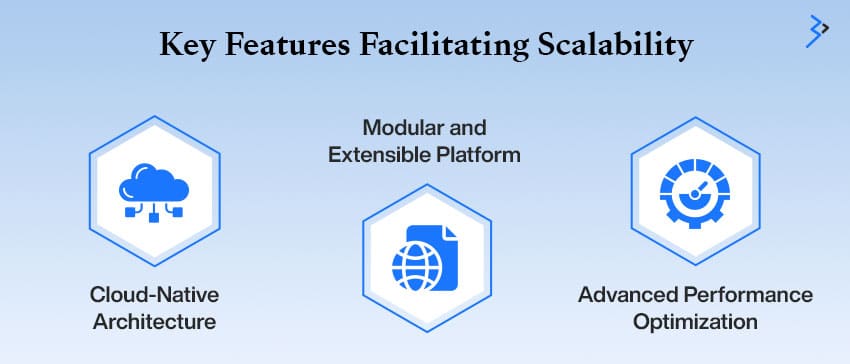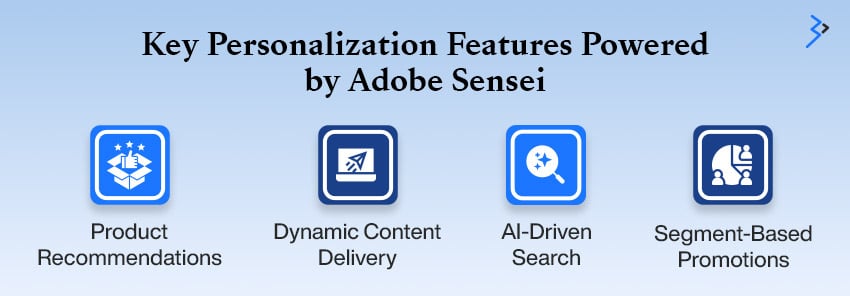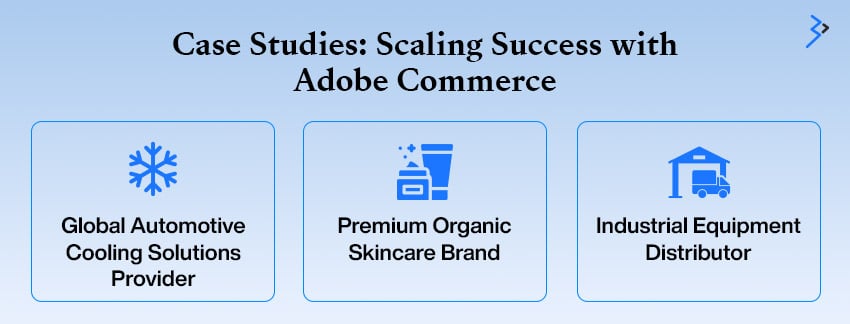The digital marketplace is evolving rapidly, making scalability a must for growing eCommerce businesses. Whether meeting rising customer expectations, entering new markets, or managing sudden traffic spikes, companies need a platform that can adapt easily. Adobe Commerce, powered by Adobe Application Cloud Services (AACS), delivers a flexible and reliable solution to support growth every step of the way.
This guide delves into how Adobe Commerce on AACS can effectively scale your eCommerce operations, ensuring performance, reliability, and a seamless customer experience.
1. Understanding Adobe Commerce on AACS
Adobe Commerce Development Services, formerly known as Magento Commerce, is a powerful eCommerce platform that provides businesses with the tools needed to create personalized and engaging shopping experiences. When integrated with Adobe Application Cloud Services (AACS), it offers enhanced capabilities, including:
- Cloud-Native Infrastructure: Ensures high availability, scalability, and resilience.
- Microservices Architecture: Allows for modular development and deployment.
- API-First Approach: Facilitates seamless integration with third-party applications and services.
By leveraging AACS, businesses can benefit from a platform designed to handle modern eCommerce’s complexities, from high traffic volumes to personalized customer interactions.
2. Key Features Facilitating Scalability

Scalability is not just about handling more traffic—it’s about doing so without compromising performance, security, or user experience. Adobe Commerce, especially when deployed on Adobe Application Cloud Services (AACS), is designed to help businesses grow smoothly and sustainably. Here are the three core features that empower businesses to scale confidently:
Read More – Optimizing the Mobile Experience on Your Adobe Commerce Cloud Store
2.1 Cloud-Native Architecture
Adobe Commerce’s cloud-native design is a game-changer for modern eCommerce operations. Rather than relying on fixed infrastructure, the platform automatically adjusts resources based on real-time demand. This dynamic scalability ensures stability, speed, and efficiency, especially during high-traffic events such as product launches or seasonal sales.
Benefits include:
- Auto-scaling infrastructure: Resources are automatically added or reduced based on user activity.
- Global reach: Cloud hosting ensures faster load times and content delivery across geographies.
- High availability: Built-in redundancy and failover support reduce downtime risks.
- Reduced IT overhead: No need for manual server management or hardware provisioning.
This elasticity enables businesses to handle large traffic volumes without service interruptions, delivering a frictionless shopping experience even during peak hours.

2.2 Modular and Extensible Platform
Adobe Commerce’s modular architecture is designed with growth in mind. Businesses can enhance or modify their eCommerce capabilities as they evolve—without having to rebuild the entire platform.
Key highlights:
- Plug-and-play extensions: Thousands of ready-made modules to expand functionality.
- Custom module development: Build bespoke features tailored to your business model.
- Isolated updates: Update specific features without affecting the whole system.
- Microservices-friendly: Supports decoupled services that scale independently.
This extensibility allows businesses to innovate continuously—adding new integrations, experimenting with features, or expanding to new markets—all while maintaining platform stability and performance.
2.3 Advanced Performance Optimization
Adobe Commerce is optimized for performance from the ground up, ensuring fast load times, efficient operations, and a seamless user experience. It incorporates built-in tools and follows best practices that help maintain top-tier performance, regardless of traffic or complexity.
Performance-enhancing features include:
- Full-page caching: Reduces load times by delivering pre-rendered pages instantly.
- Optimized database queries: Faster data retrieval ensures quicker page loads.
- Efficient asset management: Compresses and bundles CSS, JavaScript, and image files for better performance.
- Content Delivery Network (CDN) support: Accelerates asset delivery across global locations.
Additionally, tools like Adobe Experience Manager Services and New Relic offer performance monitoring, diagnostics, and insights that help businesses fine-tune their setup and quickly resolve issues.
Together, these three features create a powerful framework for growth. Whether you’re handling your first major flash sale or scaling internationally, Adobe Commerce gives you the tools to grow without friction. The combination of cloud flexibility, modular adaptability, and performance-driven design ensures your business can expand confidently while maintaining an excellent customer experience.
3. Enhancing Customer Experience Through Personalization
In today’s highly competitive digital marketplace, personalization is no longer optional—it’s essential. Adobe Commerce Cloud Service, powered by Adobe Sensei (Adobe’s AI and machine learning engine), transforms generic shopping journeys into uniquely tailored experiences for each visitor.
Adobe Sensei intelligently analyzes user behavior, purchase history, and real-time interactions to deliver relevant product suggestions and targeted content, ensuring that every customer feels seen, valued, and understood.
Key Personalization Features Powered by Adobe Sensei:

- Product Recommendations: Displays items based on user browsing patterns, previous purchases, and interests.
- Dynamic Content Delivery: Adjusts banners, landing pages, and messaging in real-time to suit individual users.
- Segment-Based Promotions: Provides exclusive discounts, bundles, or incentives tailored to specific customer groups (e.g., first-time buyers, VIPs, or cart abandoners).
- AI-Driven Search: Enhances search results with predictive typing and context-aware filtering to improve discoverability.
Read More – How to Set Up and Launch Your Store on Adobe Commerce Cloud
Impact of Personalization on eCommerce Metrics:
| Personalization Feature | Benefit | Result |
| Product Recommendations | Shows relevant items | Increases average order value (AOV) |
| Dynamic Content | Matches user intent | Reduces bounce rate |
| Targeted Promotions | Engages specific customer segments | Boosts conversion and loyalty |
| AI Search | Speeds up product discovery | Improves user satisfaction |
By leveraging these features, Adobe Commerce helps businesses convert casual browsers into loyal customers through relevant, timely, and engaging experiences.
4. Streamlining Operations with Integrated Tools
While customer experience is crucial, backend efficiency is equally vital. Adobe Commerce supports seamless integration with a broad range of enterprise systems, streamlining operations across every touchpoint—from inventory and payment to marketing and support.
Powerful Integrations that Drive Operational Efficiency:
- ERP & CRM Systems: Integrate with platforms like SAP, Oracle, Salesforce, or Microsoft Dynamics to synchronize data and simplify workflows:
- Real-time inventory updates
- Unified customer profiles
- Streamlined order management
- Payment Gateways: Supports multiple secure payment providers (PayPal, Stripe, Authorize.net, etc.) to ensure smooth and flexible checkout options for customers worldwide.
- Marketing Automation Tools: Adobe Commerce integrates with tools like Adobe Marketo, Mailchimp, or Klaviyo to automate campaigns, segment users, and analyze engagement data.
- Shipping & Logistics Platforms: Connects with services like FedEx, DHL, and UPS for real-time tracking, automated shipping rates, and smooth delivery operations.
With these integrations, businesses can eliminate silos, enhance collaboration across departments, and accelerate time-to-market, all while minimizing manual work and operational bottlenecks.
Read More – Why Enterprises are Moving to Adobe Commerce Cloud for Scalable eCommerce
5. Case Studies: Scaling Success with Adobe Commerce

Scalability is more than just handling growth—it’s about enabling businesses to thrive in complex, competitive environments. Adobe Commerce has been instrumental in driving measurable success for companies around the globe. Let’s explore three compelling case studies that showcase how businesses scaled effectively with Adobe Commerce.
Case Study 1: Global Automotive Cooling Solutions Provider
A leading automotive company specializing in high-performance cooling systems for cars, trucks, and off-road vehicles, with both B2B and B2C operations spanning the US, UK, and Europe.
Challenge:
The company had outgrown its Magento 1 setup. They required a scalable, future-proof solution capable of supporting international commerce, dynamic product catalogs, regional personalization, and third-party tool integrations.
Solution:
Migrated to Adobe Commerce Cloud Services, embracing a cloud-native infrastructure and modular architecture. Adobe’s AI-powered tools enabled real-time personalization, while seamless integrations supported logistics, ERP, and payment systems across multiple geographies.
Results:
| Region | Key Improvement |
| US | 17.45% increase in users (YoY) |
| UK | 44.57% increase in conversion rate (YoY) |
| Europe | 16.50% increase in revenue (YoY) |
The migration empowered the company to launch region-specific storefronts, tailor promotions per market, and scale their infrastructure during seasonal spikes—all while maintaining a consistent brand identity.
Case Study 2: Premium Organic Skincare Brand
An eco-conscious skincare brand known for artisanal products made from organic ingredients and ethically sourced materials.
Challenge:
Facing rapid growth, the brand struggled to manage a growing customer base and maintain personalized experiences on their legacy platform.
Solution:
The brand gained access to Adobe Sensei’s AI personalization, multi-store capabilities, and performance optimization tools by switching to Adobe Commerce. The platform also integrated smoothly with their marketing automation and inventory management systems.
Results:
- 38% increase in returning customer purchases
- 27% improvement in page load speed
- Launched four localized stores in under 6 months
Adobe Commerce helped the brand build deeper relationships with its audience and expand into new global markets quickly and efficiently.
Read More – SEO Strategies to Boost Visibility on Adobe Commerce Cloud
Case Study 3: Industrial Equipment Distributor
A long-standing distributor of construction and industrial tools, servicing both large-scale enterprises and direct consumers.
Challenge:
The company needed to support a growing catalog of over 100,000 SKUs while offering complex B2B pricing tiers and seamless integrations with their ERP system.
Solution:
Implemented Adobe Commerce with advanced catalog management tools, customer segmentation, and B2B-specific pricing modules.
Results:
- 50% reduction in time spent on manual order processing
- 3x faster product onboarding
- 22% boost in average order value (AOV)
With Adobe Commerce, the company created a frictionless buying journey tailored to professional buyers and simplified internal operations.
6. Best Practices for Scaling with Adobe Commerce

Adobe Commerce offers a flexible, robust framework that supports scalability, but maximizing its potential requires implementing key best practices. These strategies ensure your store remains fast, reliable, and responsive as traffic grows and customer demands evolve.
6.1 Regular Performance Monitoring
Keeping a close eye on system performance helps identify and resolve issues before they impact the user experience. Adobe Commerce supports integration with performance monitoring tools like New Relic, giving you real-time insights into your application’s health.
Key advantages:
- Detect bottlenecks in backend processes
- Analyze page load times and server response
- Track resource consumption and scaling efficiency
Tip: Set up alert thresholds for CPU usage, database queries, and memory to proactively manage performance before it affects customers.
6.2 Implement Auto-Scaling
As traffic fluctuates—especially during peak shopping seasons, flash sales, or promotional events—it’s essential to scale resources automatically to meet demand. Adobe Commerce Cloud supports auto-scaling, enabling your infrastructure to expand or contract based on real-time traffic loads.
Benefits of auto-scaling:
- Maintains consistent site performance under heavy loads
- Reduces downtime risk during sudden traffic spikes
- Helps control infrastructure costs by scaling down when demand is low
Best practice: Monitor historical traffic trends to fine-tune scaling parameters for different regions or seasonal events.
6.3 Optimize Content Delivery
Fast, reliable content delivery is essential for modern eCommerce performance. Integrating a Content Delivery Network (CDN) ensures that images, videos, and other assets are served to customers from the nearest edge location, minimizing latency and improving load times.
CDN advantages:
- Improves global website speed
- Reduces server load and bandwidth costs
- Enhances customer satisfaction with faster page rendering
Recommended tools: Adobe Commerce integrates easily with CDNs like Fastly and Cloudflare for optimal content delivery.
6.4 Continuous Integration and Deployment (CI/CD)
Adobe Commerce supports modern CI/CD workflows to maintain agility while scaling. Automating development, testing, and deployment processes ensures that code changes are rolled out faster with fewer errors, keeping your platform robust and up to date.
Why CI/CD matters:
- Enables faster go-to-market for new features
- Reduces the risk of bugs in production
- Supports collaborative and iterative development
| CI/CD Component | Benefit |
| Automated Testing | Catch bugs early, before deployment |
| Version Control | Track and manage codebase changes |
| Staging Environments | Safely test updates before going live |
Pro Tip: Use Adobe Commerce’s native support for Git-based deployments to automate your workflows with tools like Jenkins, GitLab CI, or Bitbucket Pipelines.
Read More – Integrating Adobe Commerce Cloud with Adobe Experience Manager
Mastering eCommerce Growth with Adobe Commerce on AACS
Scaling an eCommerce business requires a platform that’s not only robust and flexible but also equipped with tools to handle the complexities of modern digital commerce. Adobe Commerce on AACS offers businesses the infrastructure, features, and integrations needed to grow efficiently and effectively.
By leveraging its cloud-native architecture, modular design, and advanced personalization capabilities, businesses can ensure they are well-equipped to meet current demands and future challenges.
FAQs
Adobe Commerce on Adobe Application Cloud Services (AACS) is a cloud-native, fully managed version of Adobe Commerce. It provides scalable, secure, and resilient infrastructure and deeper integrations into the Adobe ecosystem, including Adobe Sensei and Experience Cloud tools. It offers better scalability, faster deployments, and built-in performance optimizations than self-hosted or Adobe Commerce without AACS.
Yes. Adobe Commerce is designed to support B2B, B2C, and even hybrid business models. It includes features like customer-specific pricing, custom catalogs, quote management, account hierarchies for B2B, and advanced personalization and promotional tools for B2C, making it versatile for diverse business needs.
Through its cloud-native architecture and auto-scaling capabilities, Adobe Commerce on AACS dynamically allocates resources to handle spikes in traffic. Features like full-page caching, Content Delivery Networks (CDNs), and performance monitoring tools like New Relic help maintain fast load times and site stability under pressure.
While Adobe Commerce is a robust platform often favored by enterprises, it’s equally suitable for mid-sized businesses looking to scale rapidly. Its modular nature allows businesses to start with core features and expand as needed, and AACS simplifies infrastructure management, making it accessible for companies with limited IT resources.
Adobe Commerce supports a wide array of integrations, including ERP systems (like SAP, NetSuite), CRMs (like Salesforce), marketing platforms (Adobe Campaign, Mailchimp), payment gateways (PayPal, Stripe), and shipping solutions. Its API-first approach ensures compatibility with virtually any third-party service or custom application.
Using Adobe Sensei’s AI capabilities, Adobe Commerce delivers dynamic product recommendations, personalized content blocks, and targeted promotions based on user behavior, purchase history, and demographic data. This helps increase engagement, average order value, and customer loyalty.
While Adobe Commerce is a powerful platform with deep customization capabilities, AACS reduces the burden of managing infrastructure and hosting. Businesses still benefit from having developers for theme customization, module development, and integrations, but Adobe provides support, automated updates, and monitoring tools to simplify operations.
Related Articles
-
Empowering Your Business with Analytics: Making Informed Choices Using Adobe Commerce Data
Both technology and shopping trends are always in a state of constant evolution. Any company that doesn’t adapt to these changes is bound to see failure in the long run.
-
How to Set Up and Launch Your Store on Adobe Commerce Cloud?
Summary Setting up an Adobe Commerce Cloud store has to be one of the most exciting yet challenging journeys. Adobe Commerce Cloud offers digital entrepreneurs a unique platform for quickly
-
Using Adobe Commerce for B2B eCommerce: Features You Need to Know!
Summary Adobe Commerce (previously Magento) is a secure, flexible, and comprehensive enterprise eCommerce platform that allows you to create world-class B2C and B2B experiences, all from a single platform. Thanks




